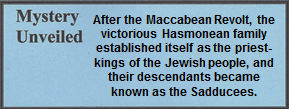03.05.06 135-63 B.C. True Independence; Rule of the Hasmoneans
With the Greeks defeated, the Jewish people had complete freedom. The Maccabean family gained control of the temple in 164 B.C. and complete control of the land by 135 B.C. Except for a few short periods when the Pharisees ruled, the Hasmoneans (eventually known as the Sadducees) continued control until the Roman conquest in 63 B.C. Under Roman rule, the Sadducees controlled the temple until its destruction in A.D. 70. While the Maccabees/ Hasmoneans were descendants from the tribe of Levi, they placed various individuals in positions of power regardless of their ancestry — a violation of the Mosaic code. But something wasn’t quite right. National sovereignty in ancient history was defined as follows:
- People did not have to pay tribute (taxes) to any foreign overlord.
- People had the opportunity to prosper, and in a limited sense were a self-determining people.
But as the Jews discovered, most of their leaders were just as corrupt as were their foreign overlords. It did not take long for the common people, who had been oppressed by foreigners, to be oppressed by their own leaders. In this miserable state, they cried out to God for a messiah who would deliver them from the oppression of their own dictators. Below is a list of their rulers.[1]
Simon 143-135 B.C.
John Hyrcanus 135-104 B.C.[2]
Aristobulus I 104-103 B.C.[3]
Alexander Jannaeus 103-76 B.C.[4]
Alexandra Salome 76-67 B.C.[5]
Aristobulus II,[6] Hyrcanus[7] 67-63 B.C.
Hyrcanus II 63-40 B.C.[8] (Puppet king of Rome)
Antigonus 40-37 B.C.[9] (Puppet king of Rome)
After the last Hasmonean ruler, Antigonus, Herod the Great took control. It is noteworthy to recognize that while the Jews believed they could now resurrect the former glory of King David, that dream never materialized. The leaders of the revolt created their multi-purpose monarch who served as king, priest (or appointed a priest) and military general. Their dynasty would be filled with corruption, murder, and deceit. With the exception of the reign of Antiochus IV Epiphanes, the common people were in no better position than with an ordinary pagan ruler.
After a long hard-fought struggle to gain freedom from the Greeks, the Hasmoneans were not about to subject themselves to a foreign power again. So they constructed a series of seven fortresses at strategic locations for protection and signal communication.[10] For example, daytime smoke signals and nighttime fire signals at the Machaerus fortress, east of the Dead Sea, were visible from all other fortresses including the fortress beside the temple in Jerusalem.[11] In fact, smoke from the temple altar was visible at Machaerus,[12] and priests would regularly go to the pinnacle of the temple at sundown on Fridays, and by a fire flare, declare the beginning of Shabbat. That fire signal was relayed and within a few moments every village in the land knew that the day of rest had begun. However, to irritate the Jews, the Samaritans from time to time sent out a false signal.[13] Little wonder then, that there was no great love between Jews and Samaritans during the days of Jesus.
Years later, during the reign of Herod the Great, these fortresses would play a significant role in maintaining peace in a tension-filled country. The Hasmoneans built a massive defense system which Herod expanded, and the foundations of the military hostile environment in which Jesus ministered were established at this time.

[1]. For a list of terms of service of the Annas family temple priests and selected first century Roman rulers, see Appendix 1.
[2]. Josephus, Antiquities 13.10.7; See also the writings of an unknown author in 1 Maccabees 16.
[3]. Josephus, Antiquities 13.11.3; Wars. 1.3.
[4]. Josephus, Antiquities 13.11.5; Wars 1.4.
[5]. Josephus, Antiquities 13.11.6; Wars 1.5.
[6]. Josephus, Antiquities 14.1-4; Wars 1.6-7.
[7]. Josephus, Antiquities 13.16.2; 14.1.3 – 3.2.
[8]. Josephus, Antiquities 14.5-13; Wars 1.8-13.
[9]. Josephus, Antiquities 14.14-16; Wars 1.14-18.
[10]. The seven major fortresses are: (1) the Alexandrium (also known as Alexandreion or Sartaba) in the Jordan Valley to defend the northern region, (2) Masada border palace fortress in the southern region, (3, 4) the Doq and the Cypros (Kypros) border fortresses that overlooked Jericho, (5) the Hyrcania Prison fortress, (6) the Machaerus, on the eastern edge of the Dead Sea, and (7) in Jerusalem, a palace-fortress beside the temple, that was later renamed by Herod the Great as the Antonia Fortress. Some fortresses, such as the Herodian, were his in original contruction while he modified other fortresses such as the Antonia, Masada, and Machaerus. For more information on Herod’s fortresses, see Samuel Rocca, The Forts of Judaea 168 BC-AD 70. New York / London: Osprey Publishing 2008. See location map at 03.05.26.Z.
[11]. Voros, “Machaerus: Where Salome Danced.” 33-34.
[12]. Mishnah, Tamid. 3.8.
[13]. Vincent, Word Studies in the New Testament. 2:113.